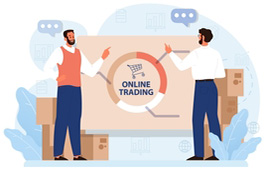
The e-commerce and retail industry is evolving at an unprecedented pace, driven by technological advancements and changing consumer behaviors.
To stay competitive, businesses must adapt to the latest trends that are shaping the future of online shopping. In this article, we’ll explore the top e-commerce trends for 2024 that every retailer should know to thrive in the digital marketplace.

E-commerce Solutions

Business-to-Consumer (B2C)

Business-to-Business (B2B)

Consumer-to-Consumer (C2C)

Consumer-to-Business (C2B)

Business-to-Government (B2G)


Why choose OIS as Your
E-commerce & Retail Business companion ?
In the fast-paced world of e-commerce and retail, choosing the right partner can make all the difference in your success. At OIS, we specialize in delivering cutting-edge solutions tailored to the unique needs of your business. Here’s why partnering with us is the smart choice for driving growth and staying ahead in the competitive retail landscape:

Expertise and Experience
With over 5+ years of experience in the E-commerce and retail industry, OIS has a proven track record of helping businesses succeed online. Our team of experts understands the intricacies of digital retail and is dedicated to providing solutions that meet your specific goals. Whether you’re a startup or an established brand, we have the expertise to elevate your business.
Comprehensive E-commerce Solutions
At OIS, we offer a full suite of e-commerce services designed to streamline your operations and enhance the customer experience. From robust website development and secure payment gateways to inventory management and logistics, we cover every aspect of your online business. Our solutions are scalable and customizable, ensuring they grow with your business.
Cutting-edge Technology
We leverage the latest technology to keep your business at the forefront of the industry. Our platforms are built with advanced features like AI-driven personalization, mobile optimization, and real-time analytics. This ensures your customers enjoy a seamless shopping experience while you gain valuable insights into their behavior and preferences.
Personalized Customer Support
At OIS, we believe in providing personalized support to our clients. We assign a dedicated account manager to every project, ensuring you receive the attention and guidance needed to achieve your business objectives. Our team is available around the clock to address any concerns and provide ongoing support as your business evolves.
Proven Results
Our clients consistently see significant improvements in key performance metrics such as conversion rates, customer retention, and average order value. By focusing on data-driven strategies and continuous optimization, we help you achieve measurable results that contribute to long-term success.
Commitment to Innovation
The retail landscape is constantly changing, and we’re committed to keeping your business ahead of the curve. We stay on top of the latest trends and innovations in e-commerce, from omnichannel integration to sustainable practices. By partnering with OIS, you gain access to the tools and strategies needed to adapt and thrive in an ever-evolving market.
Competitive Pricing
We understand the importance of cost-efficiency in running a successful retail business. That’s why we offer competitive pricing without compromising on quality. Our flexible pricing models ensure you get the best value for your investment, whether you need a full-scale e-commerce solution or specific services to enhance your existing operations.
Trusted by Leading Brands
OIS is the trusted partner for some of the biggest names in the retail industry. Our portfolio of successful projects speaks for itself, with clients ranging from emerging startups to established global brands.
Let's start a conversation
Please provide all the information and our team will reach out to you within 24hrs.
Customer Stories
Beatae vitae dicta sunt explicabo. Nemo enim ipsam voluptatem quia voluptas sit aspernatur aut odit aut fugit, sed. Beatae vitae vitae dicta sunt explicabo emo enim lorem ipsum dolor sit.

Milana Brooks
Beatae vitae dicta sunt explicabo. Lorem ipsum dolor sit amet, consectetur nemo enim ipsam voluptatem quia voluptas sit aspernatur aut odi. Beatae vitae vitae dicta sunt explicabo amet.

Anna Lewis
Beatae vitae dicta sunt explicabo. Nemo enim ipsam voluptatem quia voluptas sit lorem ipsum dolor sit amet, consectetur aspernatur. Beatae vitae vitae dicta sunt deserunt mollit anim.

Piter Bowman
Answers to your common questions
E-commerce, or electronic commerce, refers to the buying and selling of goods or services over the internet. It includes online retail (B2C), online marketplaces, and business-to-business (B2B) transactions. E-commerce allows businesses to reach a global audience, operate 24/7, and offer a seamless shopping experience.
E-commerce operates entirely online, allowing customers to browse, purchase, and receive products through digital platforms. Traditional retail involves physical stores where customers can visit, see products in person, and make purchases. While traditional retail offers tactile experiences, e-commerce provides convenience, wider product availability, and often lower prices.
E-commerce offers several advantages, including:
- Wider Reach: Access to a global customer base.
- Lower Operating Costs: Reduced expenses related to physical stores.
- Data Insights: Detailed analytics on customer behavior and preferences.
- Convenience: Ability to operate 24/7, providing a consistent revenue stream.
- Personalization: Tailored shopping experiences through AI and machine learning.
Some of the latest trends include:
- Mobile Commerce (M-Commerce): Increasing sales through mobile devices.
- Social Commerce: Selling products directly through social media platforms.
- Sustainable Shopping: Growing consumer demand for eco-friendly products.
- Omnichannel Retailing: Seamless integration between online and offline channels.
- Voice Search: Optimization for voice-activated searches via smart devices.
To start selling online, you can follow these steps:
- Choose a Platform: Select an e-commerce platform like Shopify, WooCommerce, or Magento.
- Set Up Your Store: Customize your online store with product listings, payment gateways, and shipping options.
- Market Your Business: Use digital marketing strategies like SEO, social media, and email campaigns to attract customers.
- Monitor and Optimize: Track performance metrics and continually optimize your store for better results.
Omnichannel retailing is a strategy that provides customers with a unified shopping experience across multiple channels, both online and offline. This means customers can seamlessly switch between shopping on your website, mobile app, social media, and physical store, with consistent branding and service at each touchpoint.
Mobile optimization is crucial, as a significant portion of online shopping is done via smartphones and tablets. A mobile-optimized site ensures that your store is accessible, user-friendly, and fast-loading on mobile devices, leading to higher conversion rates and improved customer satisfaction.
SEO (Search Engine Optimization) is vital for driving organic traffic to your online store. By optimizing your website content, product descriptions, and metadata with relevant keywords, you can improve your search engine rankings, making it easier for potential customers to find your products.
To ensure secure transactions, e-commerce businesses should:
- Use SSL Certificates: Encrypt sensitive data during transactions.
- Implement Secure Payment Gateways: Use trusted payment processors like PayPal or Stripe.
- Regularly Update Software: Keep your e-commerce platform and plugins up to date to protect against vulnerabilities.
- Comply with PCI DSS: Follow the Payment Card Industry Data Security Standards to safeguard payment information.
Social commerce involves selling products directly through social media platforms like Instagram, Facebook, Telegram and LinkedIn It benefits businesses by tapping into the vast user base of these platforms, leveraging social proof and influencer marketing, and simplifying the purchase process with in-app shopping features.
The future of e-commerce will likely include further advancements in AI and automation, increased use of AR/VR for immersive shopping experiences, continued growth of mobile commerce, and a stronger emphasis on sustainability and ethical practices. Additionally, the integration of blockchain technology for secure and transparent transactions is expected to rise.
